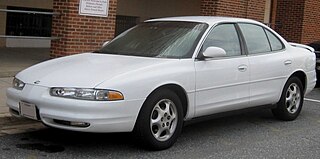Related Research Articles

A hatchback is a car body configuration with a rear door that swings upward to provide access to the main interior of the car as a cargo area rather than just to a separated trunk. Hatchbacks may feature fold-down second-row seating, where the interior can be reconfigured to prioritize passenger or cargo volume.

The Cadillac Eldorado is a luxury car manufactured and marketed by Cadillac from 1952 until 2002 over twelve generations.

The Oldsmobile Cutlass was a series of automobiles produced by General Motors' Oldsmobile division between 1961 and 1999. At its introduction, the Cutlass was Oldsmobile's entry-level model; it began as a unibody compact car, but saw its greatest success as a body-on-frame intermediate. The Cutlass was named after Vought F7U Cutlass, as well as the type of sword, which was common during the Age of Sail.

A suicide door is an automobile door hinged at its rear rather than the front. Such doors were originally used on horse-drawn carriages, but are rarely found on modern vehicles, primarily because they are perceived as being less safe than a front-hinged door. Being rear-hinged, if the vehicle was moving and the door opened, the driver/passenger would have to lean forward and out of the vehicle to close it. As seat belts were not in common use at that time, the risk of falling out of the car and into traffic was high, hence the name "suicide door".

The Buick Riviera is a personal luxury car that was marketed by Buick from 1963 to 1999, with the exception of the 1994 model year.

The Oldsmobile Toronado is a personal luxury car manufactured and marketed by the Oldsmobile division of General Motors from 1966 to 1992 over four generations. The Toronado was noted for its transaxle version of GM's Turbo-Hydramatic transmission, making it the first U.S.-produced front-wheel drive automobile since the demise of the Cord 810/812 in 1937.

The Oldsmobile Intrigue is a mid-size sedan that was manufactured from 1997 through 2002 by Oldsmobile. The Intrigue's design cues were first seen in 1995 with the Oldsmobile Antares concept car, being unveiled in production form in January 1996 at the North American International Auto Show. The Intrigue was the first casualty in the three-year phase-out process of Oldsmobile; Olds' remaining models would last an additional year or two.

The Oldsmobile Aurora is a luxury sedan, manufactured and marketed by General Motors from 1994 until 2003 over two generations — sharing platforms with Buick Riviera and using the Cadillac-derived G platform. At the time of production, the Aurora was the flagship vehicle in the Oldsmobile lineup. It originated as the 1990 Cadillac Aurora concept using the Allante 4.5 V8 engine and all-wheel drive.

The Oldsmobile Alero is a midsize car that was produced by General Motors for its Oldsmobile division. Introduced in 1998 as a 1999 model, the Alero was the replacement for both the Achieva and Cutlass. The Alero was Oldsmobile's last new model nameplate, and — on April 29, 2004 — was also the last Oldsmobile manufactured.

The Oldsmobile Cutlass Supreme is a mid-size car produced by Oldsmobile between 1966 and 1997. It was positioned as a premium offering at the top of the Cutlass range. It began as a trim package, developed its own roofline, and rose during the mid-1970s to become not only the most popular Oldsmobile but the highest selling model in its class.

The Oldsmobile Silhouette is a minivan manufactured by General Motors for model years 1990–2004 over two generations.

The Series 60 "Special" is a full-size car made by Oldsmobile from the 1939 through the 1948 model years. It was their entry-level model using the GM "A" body platform, giving Oldsmobile an entry level product with more standard features that would be optional on Chevrolet and Pontiac vehicles using the same platform. Initially, the engine size used was the company's flat head 6 cylinder, while senior models would use the flat head 8 cylinder. For marketing purposes, the Oldsmobile Series 60, or the Oldsmobile 66, took advantage of the national highway U.S. Route 66 established in 1926.It was with this generation that all GM vehicles experienced increased width dimensions to accommodate three passengers on the front bench seat and an additional three passengers on rear bench seat installed vehicles. This was accomplished with the deletion of running board thereby adding additional room inside the passenger compartment and upgrading the floor mounted gearshift to a steering column installed transmission gear selector for the Hydramatic automatic transmission.
The Nissan Pivo is a series of electric concept cars created by Nissan, with the first one introduced in 2005 at the Tokyo Motor Show.

The Mini Clubman is a subcompact executive car engineered and manufactured by BMW and sold under the Mini marque. The first-generation Clubman was introduced in 2007, as a variant of the Mini Hatch. A commercial version called Clubvan was added to the range in 2012. The current second-generation model is produced since 2015 and available with front- and all-wheel drive.

The Pontiac Club de Mer was a purpose-built, experimental car that was built by Pontiac for the General Motors Motorama in 1956 to celebrate General Motors' commitment to futuristic design. The brainchild of GM engineer-designer, Harley Earl, the "de Mer", or French for "of the sea", was a two-door sport Roadster that incorporated innovative breakthrough styling like a sleek, low-profile body encasing a large powerplant, a design trend used widely in LSR trials at Bonneville Salt Flats in Utah during the 1950s. One Club de Mer prototype was constructed and unveiled, along with another ¼-scale model, in Miami, Florida. As per GM's "kill order", it was reportedly scrapped in 1958.
Toyota Concept Vehicles produced between 1980 and 1989 include:

The Oldsmobile Golden Rocket was a two-seater show car built by Oldsmobile for the 1956 General Motors Motorama. The radically styled fiberglass concept, designed to resemble a rocket on wheels, was revised several times and displayed at various other auto shows, most notably at the 1957 Paris Motor Show where it generated much fanfare, 18 months after it was first revealed. The car was featured in the promotional short film Design for Dreaming along with the rest of the 1956 General Motors lineup.
References
- ↑ "2001 Oldsmobile O4".
- ↑ "Oldsmobile O4 - Concept Cars - Motor Trend". Archived from the original on 2008-07-24.
- ↑ "Oldsmobile O4 Showcase".
